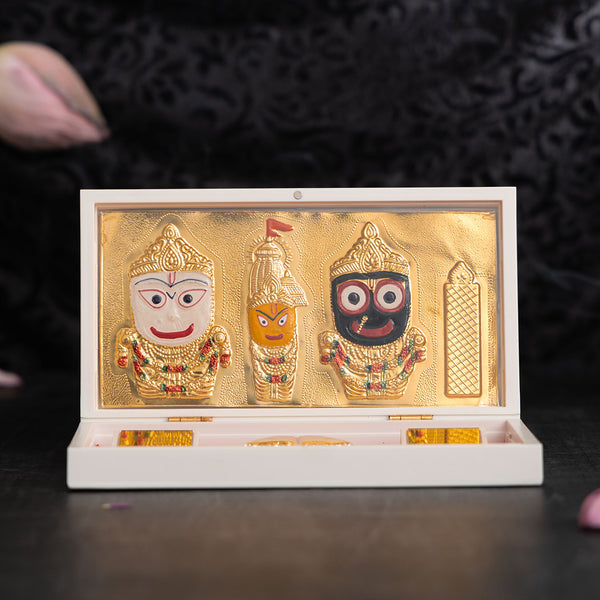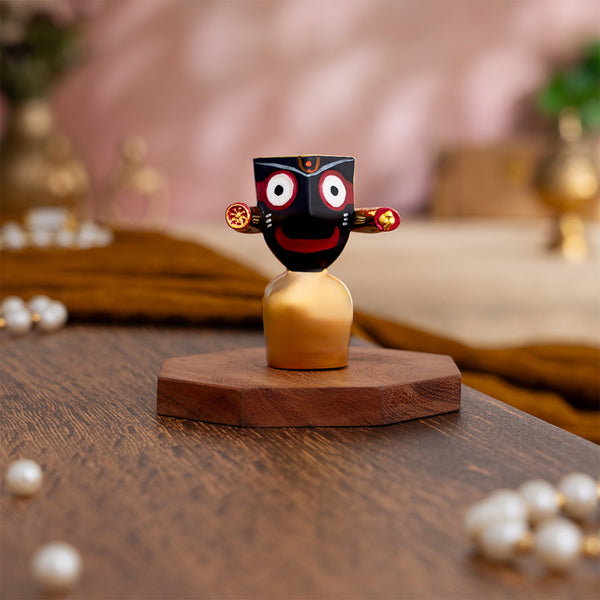In 2025, the spectacular Jagannath Ratha Yatra in Puri is set to occur on Friday, 27 June, marking the sacred journey of Lord Jagannath and his siblings that brings the city to vibrant spiritual life . With a vast and rich culture and heritage attributed to our religion, we have no lack of beautiful stories woven for our deities.
And we’re going to be looking into the origin, history, powers, and lore of Lord Jagannath. Indian Gods and Goddesses take several forms and names.
The acclaimed Lord Krishna has yet another name, Lord Jagganath. This mischievous and charming deity is one of the popular Hindu Gods, known for his charisma and naughtiness.
In Hinduism, the Brahman, or Supreme Being, is a special, all-encompassing deity. The deva and devi, or various gods and goddesses, who each stand for one of Brahman's elements, are revered in the Hindu Dharma.
The Holy Trinity of the creator, protector, and destroyer, Brahma, Vishnu, and Shiva stands out among the many Hindu Gods and Goddesses.
The triad could occasionally manifest as a deva or devi, taking on a new form. In India, each province has a unique deity.
Who is Jagannath God?

In the Indian states of West Bengal and Puri, Odisha (also known as Orissa), the Hindu god Krishna is venerated as Jagannatha (Sanskrit: "Lord of the World").
The city of Puri is dominated by the 12th-century Jagannatha Temple. The sanctuary of the temple contains wooden statues of Jagannatha, his sister Subhadra, and their brother Balarama.
Unlike the more well-known Buddha, Jagannatha is regularly portrayed as one of Vishnu's ten avatars (incarnations) in modern art produced in Puri.
Lord Jagannath is another name for Lord Krishna. They are both identical.
In order to express his transcendental feelings or maha bhava, Krishna assumed the form of Lord Jagannath. Krishna is hence same as Lord Jagannath.
Related Read: What Happened To Krishna’s Body After His Death?
No other region worships a form of Vishnu in the same way as Orissa does with Lord Jagannath, who is a unique god. He is referred to as Jagannath, the Lord of the Three Worlds: the Heavens, Earth, and the Underworld.
He is also one of Lord Krishna's incarnations, the eighth manifestation of Lord Vishnu. Many of the characteristics of Vishnu, who protects the universe that Lord Brahma created, are shared by Jagannath.
When it comes to his followers, Jagannath is gentle and sympathetic, patiently listening to their prayers before bringing them delight through a variety of vibrant festivals and the most mouthwatering food offerings. Because Jagannath is a kind and generous god, he is adored by his followers.

Lord Jagannath Puri 3D Wall Frame - Gold Plated Finish

Lord Jagannath, Subhadra, Balabhadra Murti Set - Gold Plated (4 Inch)
Meaning of Shree Jagannath
The words "Jagat" and "Natha" are combined to form the term "Jagannath." Jagat denotes "The Universe/World," whereas Natha denotes "Lord/Master."
Thus, Jagannath's name literally translates to "Lord of the Universe." Puri is known as "Jagannath Dham" or "Jagannath Puri" because it is where Lord Jagannath resides.
The Puri Jagannath Temple's principal deity is Lord Jagannath. He is revered inside the temple alongside his elder brother Lord Balabhadra, sister Subhadra, and the powerful Sudarshan Chakra (disk).
In order to represent all four races of the earth, Jagannath is black (inscrutability), Lord Balabhadra is white (enlightenment), Sister Subhadra is yellow (goodness), and Lord Sudarshan is red.
Significance of the Four Deities in Jagannath Temple
In Sanskrit, the letters "Ja" stand in for Jagannath, "Ga" for Balabhadra, "Nna" for Subhadra, and "Tha" for Sudarsan. Thus, the four deities of the Jagannath Temple are united under the name Jagannath.
His parallel arms show that he is ready to hug followers from all over the world, and his round eyes, which lack eyelids, show that he is attentive to his followers' needs even when he is not sleeping. Lord Jagannath-related matters are all Bada (any form of Greatness).
He's referred to as the Bada Thakura (The Chief among all Gods). The Bada Deula is the name of His Temple (The main temple among the temples). Bada Danda is the name of the street in front of the temple (Grand Road).
The Mahodadhi is the name of the Sea of Puri (Great Ocean). The Puri cemetery for cremations is called Swargadwar (The Gateway to Heaven).
The History and Myth About Lord Jagannath
The Hindu god Vishnu came to King Indradyumna in dreams and asked him to build a temple for him. He told the king to build the temple and then pick up a log of wood that would come floating in from the sea.
This log had to be used to carve an image of the deity Lord Nilmadhav. Vishwakarma, the architect of the gods, answered the prayers of Indradyumna and appeared before the king in the guise of an old man.
However, the log was so heavy that no one could pick it up, and again, the tribal chief Vishwavasu had to be summoned, and he carried the log to the temple.
This is the legendary explanation of the garbha griha of the temple, welcoming devotees with their kind and compassionate smiles.
The Rig Veda hymn 10.155 mentions a Daru (wooden leg) wandering in the sea as a Purusha, albeit this is open to interpretation.
The name was taken to be synonymous with Purushottama, and the Dara wood log was cited as the source of Jagannath's inspiration, placing the beginning of the deity in the second millennium BCE.
However, many academics disagree with this interpretation, arguing that the hymn belongs in the setting of Arayi's "Alaxmi Stava."
However, Lord Jagannath is referred to as Purushottama by the locals of Puri. They also see the driftwood as a symbol of their salvation, and Hindu literature from the region go on to explain how the Supreme Being is present in everything.
The Vedic connection can therefore be disputed or interpreted in various ways, but the ideas coincide nonetheless.
The Puranas claim that Lord Vishnu's Narasimha Avatar appeared as a wooden pillar. Thus, it is believed that Jagannath is worshipped with the Shri Narsimha hymn, which is dedicated to Narasimha Avatar, as a wooden idol called Daru Brahma.
As far ago as the Puranas, Lord Jagannath celebrated his Ratha Yatra. In the Padma Purana, Brahma Purana, and Skanda Purana, the celebration is described in detail.
The natives of West Bengal and a significant chunk of Orissa revere Lord Jagannath, who is known as a transcendental Hindu deity.
Sri Jagannath is thought to be one of Lord Krishna's incarnations as the eighth manifestation of Lord Vishnu. In a triumvirate with his siblings Subhadra and Balabhadra, he is highly revered.
The deity is referred to as Jagannath and is known as the Lord of the Universe, which is made up of the three terms heaven, earth, and netherworld.
Many of the qualities attributed to Lord Vishnu, who is known as the protector of the cosmos imagined by Lord Brahma, are thought to be shared by Jagannath.
It is thought that Lord Jagannath is a non-sectarian deity. In the Indian states of Manipur, Chhattisgarh, West Bengal, Jharkhand, Bihar, Odisha, Assam, Gujarat, and Tripura, he is highly revered on a local level. He holds significance for Bangladeshi Hindus as well.
The Jagannath temple at Puri, Odisha, is particularly significant to Vaishnavism and is regarded as one of India's Char Dham pilgrimage sites as well as one of the most important Hindu pilgrimage sites since roughly 800 CE.
Hindu god Lord Jagannath is revered by worshippers in India and all across the world.
Lord Jagannath is regarded as a manifestation (avatar) of Lord Vishnu. He actually possesses all of Lord Vishnu's avatars qualities. On various festivals, Lord Jagannath is worshipped in various guises.
For instance, he is commonly compared to Lord Shri Krishna, Lord Vishnu's eighth avatar. Since Lord Jagannath's idol is made of wood, he is compared to Lord Vishnu's Narasimha Avatar, who manifested as a wooden pillar.
Lord Jagannath is worshipped throughout the month of Bhadra (August–September) as the Vamana incarnation of Lord Vishnu.

Svastika Jagannath Pocket Temple - Gold Coated

Lord Jagannath Murti - Gold Plated (2.75 Inch)
Lord Jagannath Impact on Hindu Iconography
The idols of Shri Jagannath are colourfully painted and skillfully carved from a neem wooden stump. He is not portrayed as a human being, in contrast to other celestial creatures in Hinduism.
It is depicted that the pillar holding up his face and chest is fusing together. It is thought that the enormous round face represents an Anadi (without beginning) and Ananta (without end).
This wooden stump is designed to display two enormous, symmetrical, circular eyeballs that are made of wood but lack eyelids. The moon is symbolized by one eye, while the sun is represented by the other. The legs, neck, and ears are visibly absent, but two extra stumps on either side of the main stump function as the Lord's hands.
The stump is then further embellished to create Shri Jagannath's final appearance. On his forehead, he is shown with a Vaishnava U-mark. His dark skin tone and other facial traits are an abstraction of Krishna, the Hindu deity who has multiple forms.
The deity is shown alongside his brother Balabhadra and sister Subhadra at the vast majority of Lord Jagannath shrines in Eastern India and all of his important temples located in Puri, Odisha.
Famous Saints Representing Lord Jagannath

Adi Shankaracharya, a Hindu reformer and scholar who oversaw a religious revolution in the eighth century, constructed the Goverdhan Math, the oldest monastery in Puri.
Ramanujacharya, a saint and scholar, oversaw the temple's rites when he arrived in Puri in the 12th century.
In the 12th century, Vishnu Swami founded the Vishnuswami math. Here was where poet saint Chaitanya Mahaprabhu resided, and his Gaudiya Math is one of Puri's biggest monasteries.
Eventually, during his nationwide travels in the 16th century, Guru Nanak made it to this location.
Puri is home to over a hundred monasteries, with numerous temples overseen by various Vaishnava sects.
FAQs
1. Who is Lord Jagannath?
Lord Jagannath is a revered form of Lord Vishnu, especially associated with Lord Krishna. He is worshipped primarily in Puri, Odisha, as the "Lord of the Universe."
2. Why does Lord Jagannath look different from other deities?
Lord Jagannath’s unique form with large round eyes, a flat face, and no visible limbs symbolizes his universality and is believed to have tribal origins merged with Hindu traditions.
3. What is the significance of the Jagannath Temple in Puri?
The Puri Jagannath Temple is one of the four sacred Char Dham pilgrimage sites in India. It’s the main center of Lord Jagannath worship and the site of the famous Rath Yatra.
4. Can I buy Jagannath idol online?
Yes, you can easily buy Jagannath idols online from trusted spiritual stores like Svastika.in, where each idol is crafted with devotion and reflects traditional Puri-style design.
5. What is Rath Yatra and why is it important?
Rath Yatra is the grand chariot festival where Lord Jagannath, along with his siblings Balabhadra and Subhadra, is taken out in giant wooden chariots. It represents the Lord’s journey to meet his devotees.
6. What does the name "Jagannath" mean?
“Jagannath” comes from the Sanskrit words Jagat (world) and Nath (lord), meaning “Lord of the Universe.
Also Read :
Jagannath Puri Comes Alive During Ratha Yatra 2025
A Story About Hati Besha of Lord Jagannath
Lord Jagannath Rath Yatra Story
10 Interesting Facts about the Jagannath Temple
Why Jagannath Has No Hands? Explore the Enchanting Story!
Why Lord Jagannath Has Big Eyes? Revealing the Spiritual Secrets








